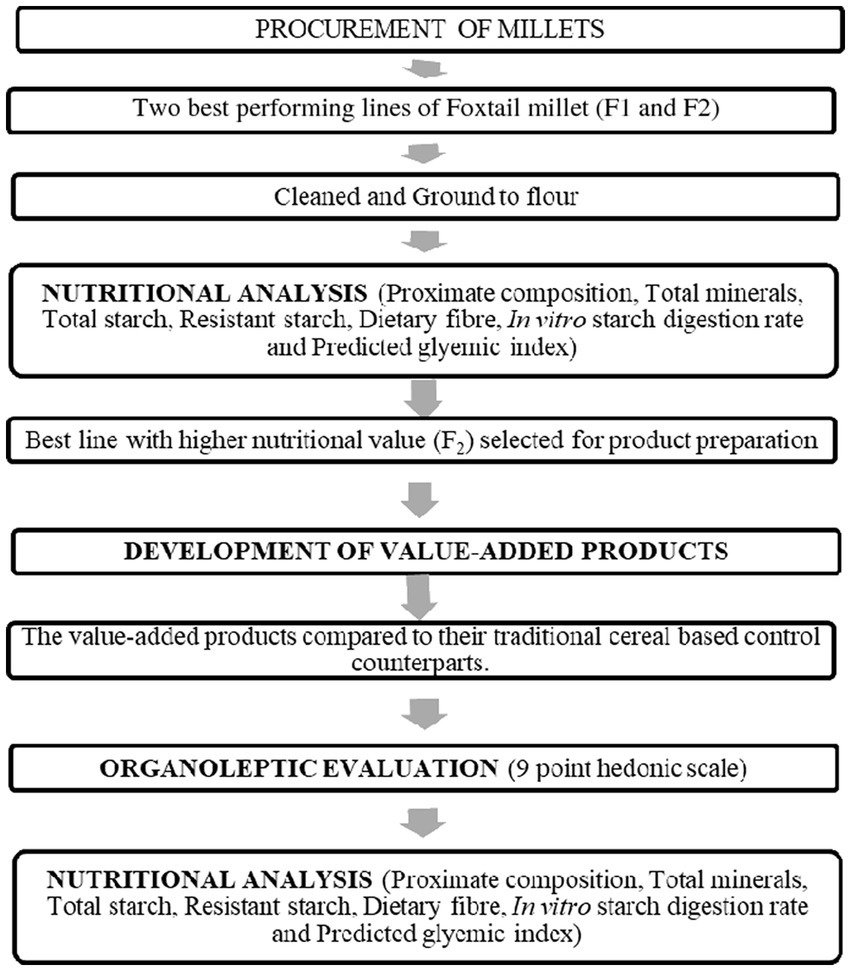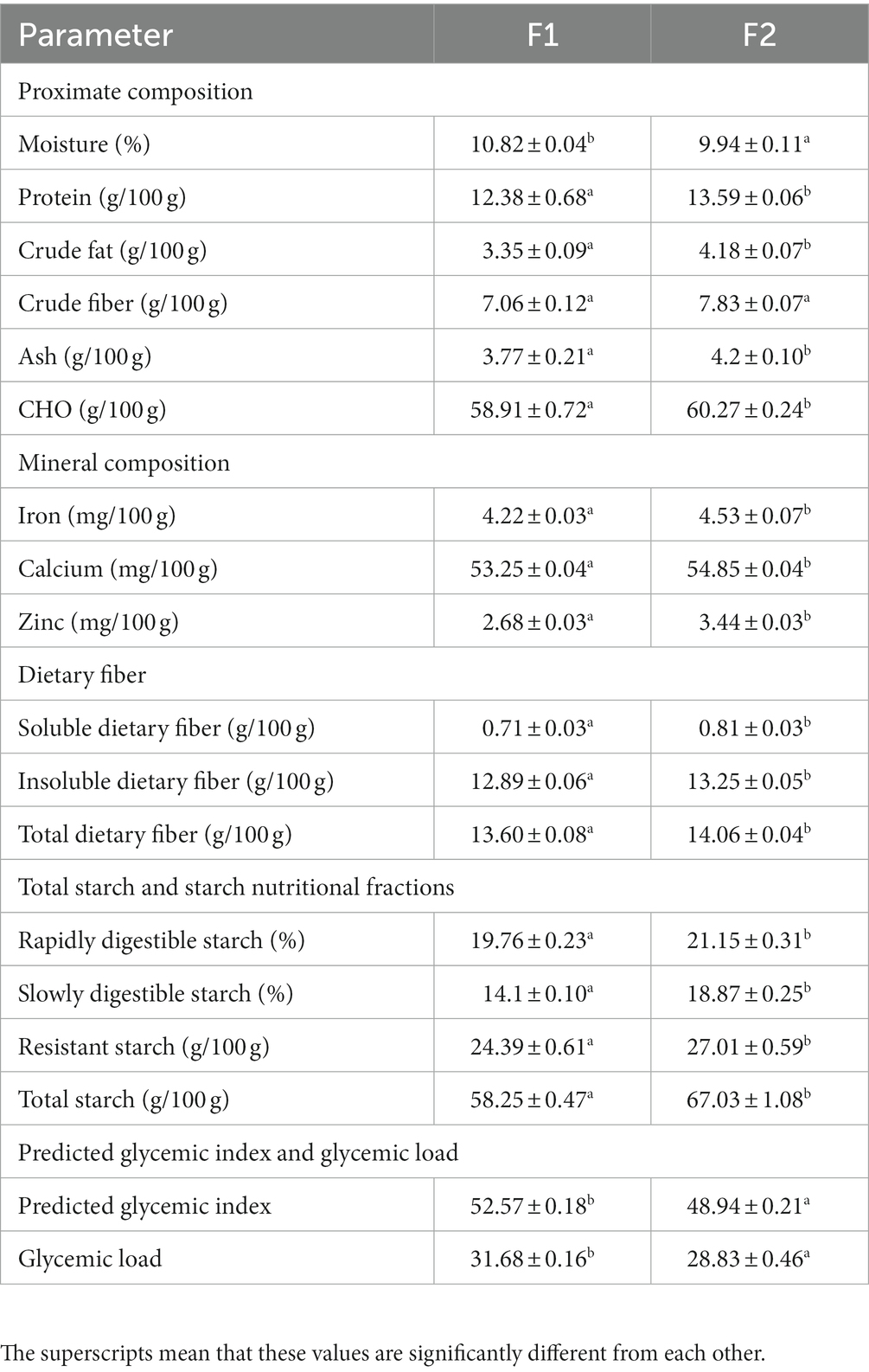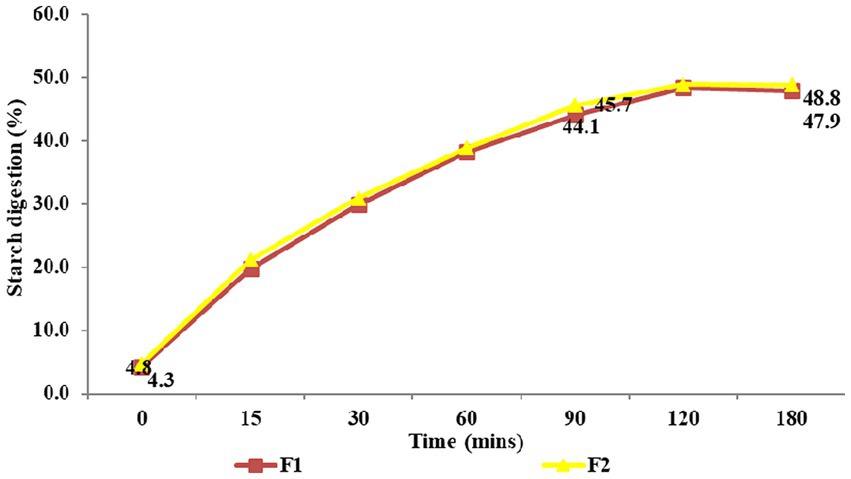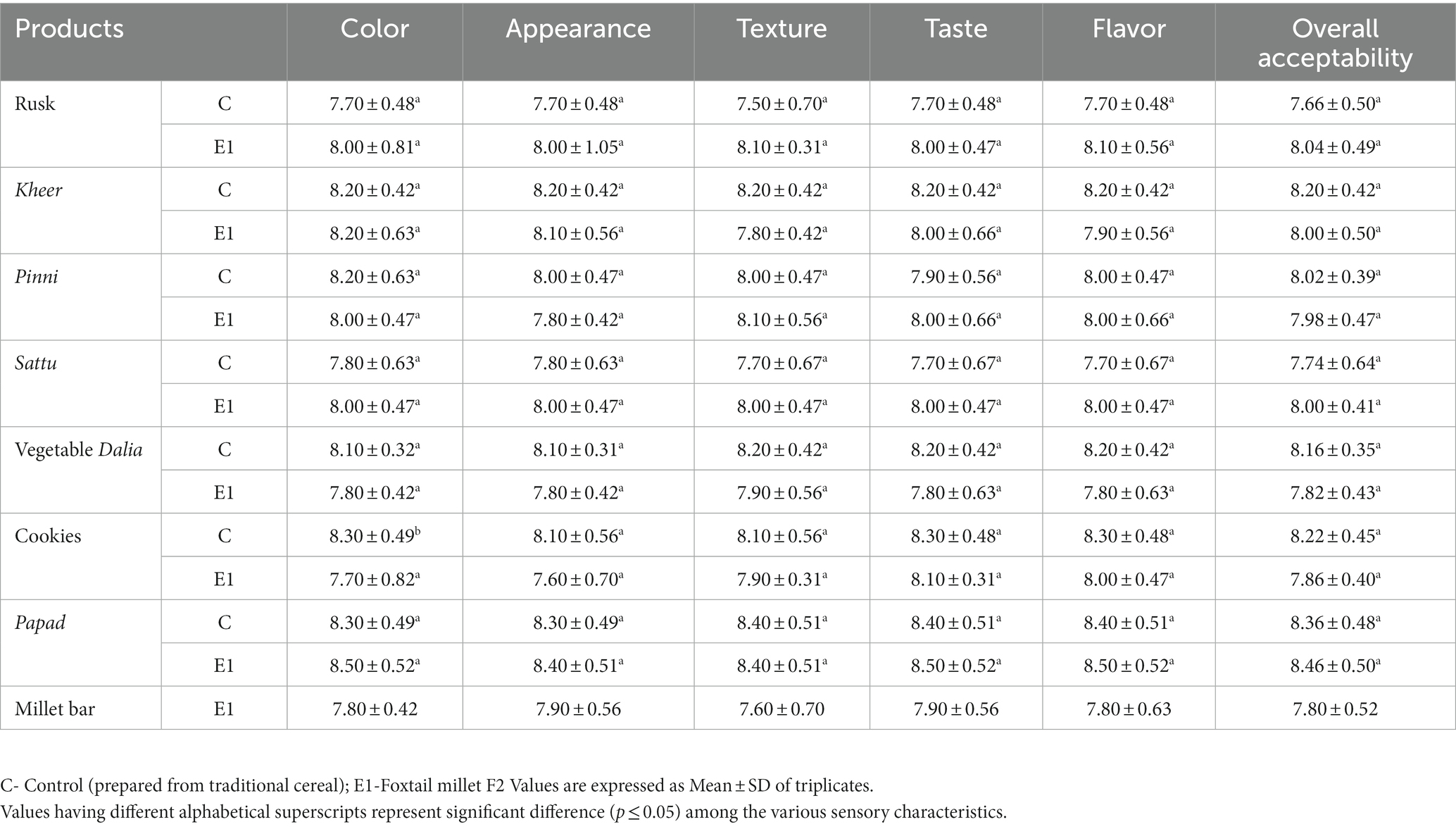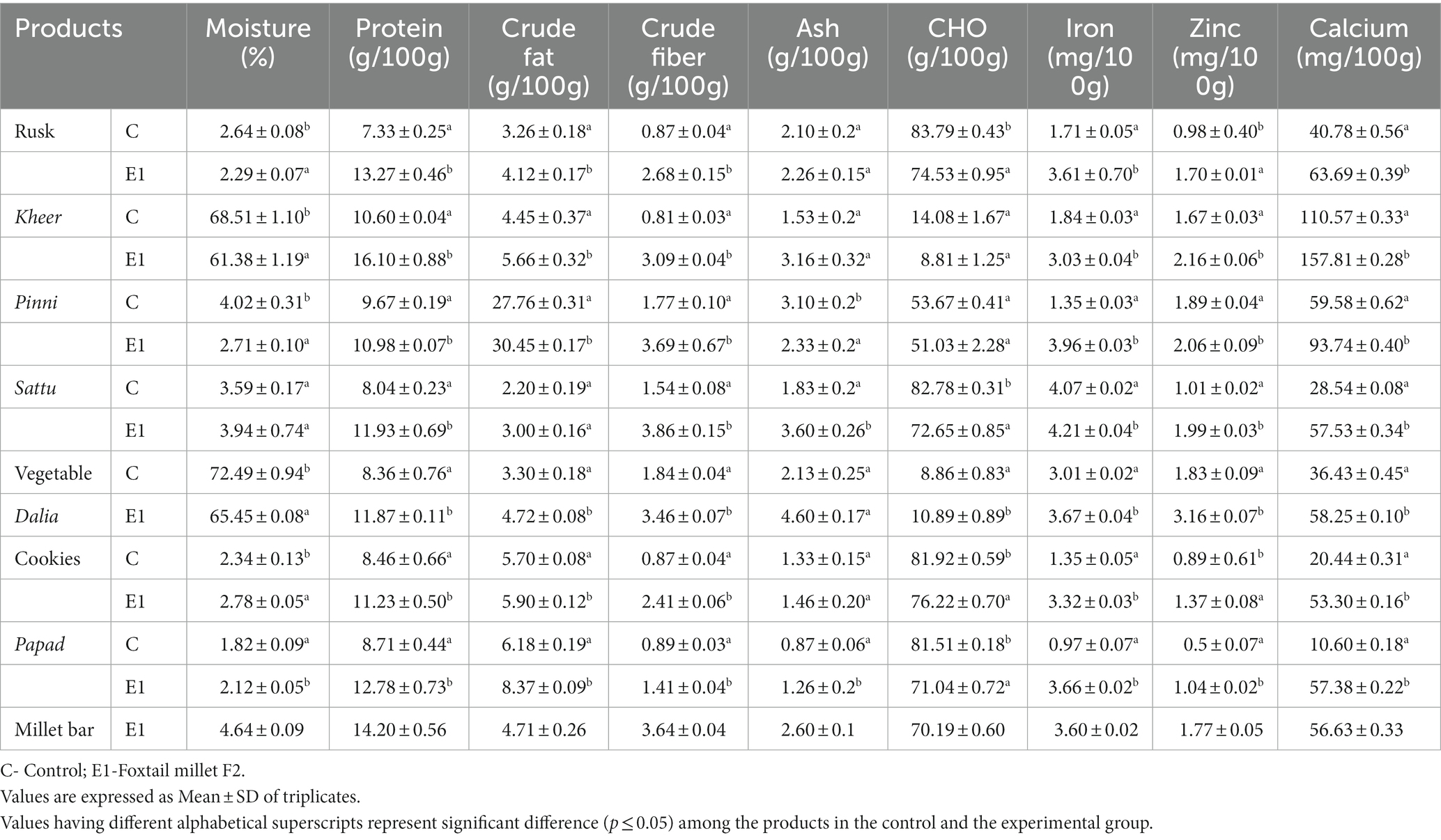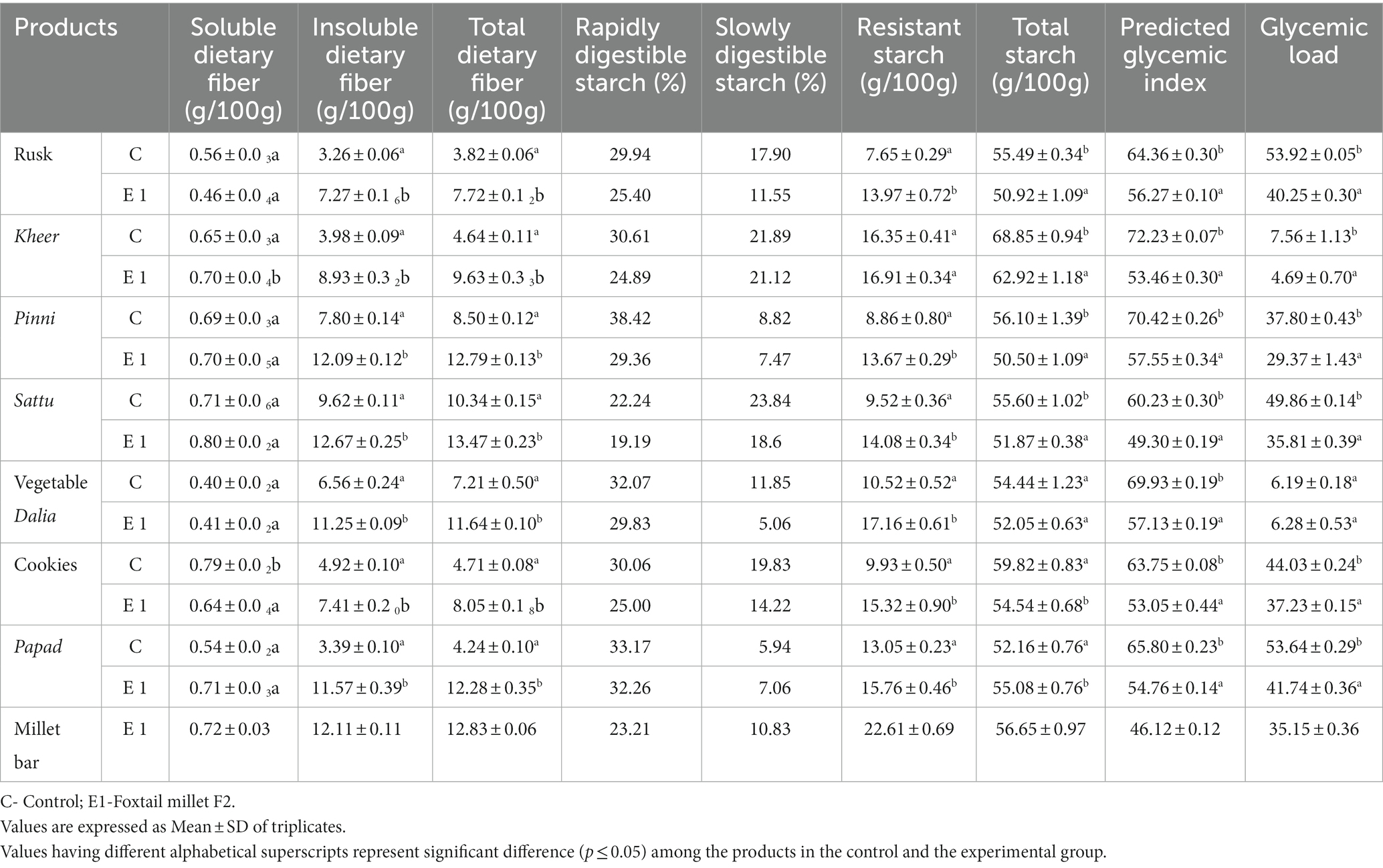- 1Department of Food Science and Technology, Punjab Agricultural University, Ludhiana, Punjab, India
- 2Department of Plant Breeding and Genetics, Punjab Agricultural University, Ludhiana, Punjab, India
- 3ICAR-Indian Institute of Wheat and Barley Research, Karnal, Haryana, India
- 4Instituto de Conservación y Mejora de la Agrodiversidad Valenciana, Universitat Politècnica de València, Valencia, Spain
Millets are a rich source of many health-promoting nutrients as well as bioactive compounds such as dietary fibers, antioxidants, macro and micronutrients etc., compared to other staple cereals such as rice, wheat and maize. These nutrients play a central role in the world nutritional security. Despite the inbuilt nutritional benefits, the production of millets has witnessed sharp decline owing to taste preferences, keeping quality and challenges associated with food preparation from millets. To sensitize the consumers about the nutritional benefits of foxtail millet, the present study was planned to formulate and nutritionally evaluate eight diversified foxtail millet-based food products namely rusk, kheer, pinni, sattu, vegetable dalia, cookies, bar and papad by replacing commonly used cereals such as wheat and rice. The products prepared from Foxtail millet were found to have high acceptability with mean score of more than 8.00. These diversified food products showed higher protein content ranging from 10.98 to 16.10 g/100 g, with the highest protein found in Foxtail millet kheer (16.01 g/100 g). The resistant starch content and predicted glycemic index (PGI) of these products ranged between 13.67 to 22.61 g/100 g and 46.12 to 57.55, respectively, with the highest resistant starch (22.61 ± 0.69 g/100 g) and lowest PGI (48.42 ± 0.20) found in millet bar. The high resistant starch and low PGI in foxtail millet products suggest that they could serve as an excellent food source suitable for diabetics. The obtained results suggest that all the Foxtail millet-based value-added products have superior nutrient profile and are highly acceptable than the traditional products. Inclusion of these foods in the diets of the population may help in the prevention of malnutrition and type 2 diabetes.
1. Introduction
With 109.52 and 122.27 million tonnes of production in 2021 (1), India is the world’s second largest producer of wheat and rice, respectively (2). The cultivation of staple grains like wheat and rice in the Indo Gangetic Plains significantly contributed to the green revolution and helped to ensure the country’s food security. However, unbalanced fertilizer application, decreased soil fertility owing to nutrient depletion, decreased recycling of soil and water resources, anomalies in the pH of the soil and water balance, a rise in disease and rodent incidence, and the destruction of natural ecosystems are all variables that have a detrimental impact on the production systems’ ability to sustain itself (3). Therefore, farming practices must be diversified such that they are both environmentally sustainable and nutritionally appropriate. Crop diversification is required not only to address the issues arising from wheat-rice farming system, but also to address the situation of globally rising non-communicable diseases (NCDs) and malnutrition. NCDs are caused by an interplay of biological systems with dietary variables, such as a lack of nutrient-rich functional foods and an abundance of quickly absorbed energy-rich foods (4). People’s lifestyles and eating habits have been significantly altered by globalization and industrialization, which have led to weakened immunity and thus leading to non-communicable diseases (5). The rising trend of refined cereal intake aggravates the health situation further, leading to overnutrition and NCDs among different population groups worldwide.
Millets, also known as Nutri-cereals, are a type of grasses with small seeds. These were a staple diet in many countries decades ago, but are now despised as “minor grains.” They are grown all over the world as cereal grains for human and animal nutrition. However, both their production and consumption have experienced a significant fall. Poor wages, a lack of input subsidies and price incentives, and the subsidized supply of fine cereals through the public distribution system are the main causes of the decline. Additionally, a lack of understanding of the nutritional benefits, challenges in food preparation, and a lack of processing technology are some additional significant issues that have contributed to millets becoming more obsolete (6).
Many nutrients, dietary fiber, and antioxidants are deficient in diets based entirely on wheat and rice (7, 8). Compared to staple cereals, millets are nutritionally dense and encompass several health-promoting functional compounds (9). They contain high concentrations of macro and micronutrients such as proteins, dietary fiber, carbohydrates, phytochemicals and vital amino acids (10, 11). Millets have a balanced nutritional profile, and consuming them has been shown to have positive effects on health outcomes. Millets have the potential to promote diversification as well as provide food and nutrition security. Millets have a huge potential to work as alternative grains for ensuring food and nutritional security in most parts of the world, due to their high concentrations of micronutrients, dietary fiber, vitamins, and phytochemicals with diverse therapeutic applications (12). It was stated that the presence of high amounts of polyphenols and other bioactive compounds in millets increase the rate of fat absorption and the time of release of sugars, thereby decreasing the glycemic index (13). The quality as well as quantity of dietary fiber and resistant starch in the millet grain is better than the other cereals. These components aid to provide a feeling of prolong fullness and prevention of constipation. Moreover, due to the presence of tryptophan, consumption of millets leads to more production of serotonin, causing a soothing effect on human mind. It was reported that millet’s fiber binds to toxins in stomach and may help in the protection against colon cancer (14). Another study reported that protein extracted from foxtail millet bran exhibits anti-colon cancer properties and may be used as a therapeutic treatment for colon cancer (15).
A study conducted on type 2 diabetic patients by supplementing their diet with millets. The results showed that the supplementary diet improved the levels of antioxidant, vitamins, calcium, magnesium and hemoglobin (16). The HbA1C, blood sugar, blood pressure and pro inflammatory cytokines were also found to be decreased with the millet-based diet. Similarly, it was reported that millet exhibit hypolipidemic effect by regulating lipid metabolism related genes expression or gut microbiota composition (17).
Due to the health-promoting properties of millets, production and development of millet-based products is gaining support in different parts of the world. The introduction of new technology for the production of alternative foods, commercial goods, and animal feed has the potential to increase millet’s demand. They can be used in both traditional and innovative foods. Millets have been successfully used to make cakes, cookies, pasta, parboiled rice- like products, and snack foods (18). Foxtail millet was used to create an unfortified weaning mix with acceptable sensory and rheological properties (19), a composite bread having low glycemic index (20), ready-to-eat extruded snack (21), biscuits and burfi with low glycemic index (22), and beverages with high anti-oxidant activity (23). Foxtail millet (Setaria italica) is a minor millet that contains 11% protein, 59.1% starch, 3.9% fat, 19.1% dietary fiber, 7.0% ash and 6.6 mg/100 g of phenolic compounds (24). There is availability of huge literature on the millets like Pearl millet and Sorghum but less emphasis has been given on Foxtail millet. So, the current investigation was focussed on development and nutritional analysis of Foxtail millet-based food products, so as to provide a healthier dietary option to the vulnerable population.
2. Materials and methods
2.1. Procurement of sample
After a thorough screening of a germplasm set of 1,000 lines across 4 years, two short-duration (60–65 days) lines of Foxtail Millet (), which were moderate in yield, were shortlisted for multilocation trials across Punjab in the summer season and were considered for this study. These were namely F1 and F2, respectively, and were procured from the Department of Plant Breeding and Genetics, College of Agriculture, PAU, Ludhiana. The procured seeds were cleaned to remove any impurity and the samples were stored in air-tight containers for nutritional analysis and product development (Figure 1). The cereal grains like wheat, rice, barley and other ingredients required for the development of food products were procured from the local market.
2.2. Chemical analysis
The cleaned raw grains of the selected germplasm lines were ground to a flour using an electric grinder with 20 mesh size and was stored at ambient conditions for further nutritional analysis. The flour samples were analyzed in triplicates for proximate composition, minerals (calcium, iron, zinc), resistant starch, dietary fiber, in vitro starch digestion rate and predicted glycemic index, using the standard operating procedures described below.
2.3. Determination of proximate composition
Proximate parameters namely moisture, crude protein, crude fat, crude fiber and ash were analyzed using three replications of each raw germplasm line using the standard method given by (25). For moisture determination, 5 g of sample was weighed and placed in pre-weighed china crucibles in a hot air oven at 105°C for 8 h to dry to a constant weight. For the determination of nitrogen, the macro-kjeldahl method was used. Nitrogen was converted to crude protein using a conversion factor of 6.25. The crude fat content was determined using soxhlet assembly, where moisture-free sample was put in a thimble. Petroleum ether was used as a solvent. The extracted fat from the sample was weighed after evaporating the remaining solvent. 5 g of (moisture- and fat- free) sample was mixed with 200 ml of 1.25% H2SO4. A Buchner funnel was used to filter the sample through a cotton cloth after it had been refluxed for 30 min for the estimation of crude fat. The residue was cleaned with hot water until it was acid-free. The residue was mixed with 200 ml of 1.25% NaOH. It was refluxed for another 30 min before being filtered through muslin cloth. It was rinsed in hot water once again. The residue was transferred to the previously weighed crucible and dried for 2 h at 130°C in a hot air oven. After being ignited in a muffle furnace and cooled in a desiccator, the weight loss was estimated. The ash content was analyzed using 0.5 g of sample which was placed in previously weighed and labeled crucibles. The samples were heated to 550°C in a muffle furnace for 4 h. After cooling in a desiccator, the crucible residue was weighed again. The carbohydrate content was calculated by subtracting sum of all proximate parameters (moisture content, crude protein, crude fat, crude fiber, and total ash) from 100.
2.4. Mineral analysis
The powdered flour was digested by the addition of a triple acid combination made up of nitric acid (HNO3), sulfuric acid (H2SO4), and perchloric acid (HClO4), in the ratio of 10:4:1in order to measure iron, zinc and calcium. Following digestion, the samples were diluted and filtered, and the volume was made to 100 ml. Following the initial preparations, the amount of iron, zinc and calcium was measured by comparing with standards for these elements using an atomic absorption spectrophotometer (Analyst 200, Perkin Elmer).
2.5. Dietary fiber
The soluble, insoluble and total dietary fiber contents of the samples were analyzed in triplicates using Megazyme-K-TDFR-200A. The soluble and insoluble dietary fiber contents were analyzed using the standard protocol given by (25). The dietary fiber was calculated using the formula:
R1 = residue weight 1 from m1, R2 = residue weight 2 from m2, m1 = sample weight 1,
m2 = sample weight 2, A = ash weight from R1,
p = protein weight from R2 and
B = blank =
Where:
BR = blank residue,
BP = blank protein from BR1, BA = blank ash from BR2.
2.6. Total starch and resistant starch
The starch content was analyzed using method given by (26). Megazyme K-RSTAR assay kit was used for the estimation. Resistant starch and non-resistant (solubilized) starch were analyzed and the total amount of starch was determined by the addition of these two components.
2.7. In vitro starch digestion rate
Five hundred mg of the sample was treated for 15–20 s with 1 ml of artificial saliva containing porcine -amylase (Sigma A-3176 Type VI-B; 250 U per ml of carbonate buffer) before 5 ml of pepsin (Sigma P-6887, from gastric porcine mucosa; 1 ml per ml of 0.02 M aqueous Hydrochloric acid) was added and incubated at 37°C for 30 min in a shaking water bath. The digesta was neutralized (5 ml of 0.02 M aq. Sodium hydroxide) before the pH was set to 6 (25 ml of 0.2 M sodium acetate buffer) before adding 5 ml of pancreatin (Sigma P1750 from porcine pancreas; 2 mg per ml of acetate buffer) and amyloglucosidase (Sigma A- 7420 from Aspergillus niger; 28 U per ml of acetate buffer). The solution was incubated for 4 h, during which time the glucose concentration in the digesta was monitored using an AccuCheck® Performa® glucometer at various intervals.
2.8. Rapidly digestible starch and slowly digestible starch
The glucometer reading at 15 min was converted to the percentage of starch digested using the following equation
Where:
GG = Reading of the glucometer (mM/L)
V = Digest volume (mL),
180 = glucose’s molecular weight W = sample weight (g)
S = sample’s starch content (g per 100 g dry sample)
M = moisture percentage in sample (g per 100 g sample)
0.9 = starch stoichiometric constant from glucose concentrations.
RDS% = percentage of starch digested at 15 min
SDS% = percentage of starch digested at 120 min – percentage of starch digested at 15 min.
2.9. Predicted glycemic index
Predicted glycemic index was calculated using the method given by (27). For calculating predicted glycemic index, Hydrolysis index was worked out as:
Then, the estimated glycemic index was calculated by applying the formula defined by (27): GI = 39.71 + 0.549 HI.
Glycemic load was calculated as:
3. Development of foxtail millet- based food products
The nutritionally superior germplasm line of Foxtail millet (F2) was used for the preparation of value-added products, which were compared with the recipes prepared using traditional cereal [wheat for rusk, cookies, vegetable dalia and pinni, rice for papad and kheer (refrigerated) and barley for sattu] and was treated as control. Initially, millets were replaced with a traditional cereal (wheat, rice, and barley) at the level of 10%; however, all the products of Foxtail millet were found to be acceptable even at 100% replacement. Therefore, the recipes prepared after replacing 100% of wheat, rice and barley rice were developed and analyzed. The ingredients and procedure used to develop the value-added products are given in Table 1. Eight diversified foxtail millet-based products were developed in the category of traditional products including:
1. kheer (form of porridge prepared from milk and rice/millet);
2. pinni (mixture of roasted cereal/millet flour rolled into balls after adding ghee and sugar); baked products – rusk and cookies;
3. breakfast cereals – vegetable dalia (porridge); and snack foods – sattu (traditional drink), bar and papad.
3.1. Organoleptic evaluation of developed food products
The developed products were evaluated by a panel of minimum semi-trained individuals from the Department of Food and Nutrition, Punjab Agricultural University, Ludhiana for their sensory qualities. The panelists scored different products prepared from Foxtail millet based on their appearance, texture, taste, flavor and overall acceptability by using nine-point Hedonic rating scale (34), where 9 indicated “like extremely” and 1 indicated “dislike extremely.”
3.2. Nutritional evaluation of developed food products
The products prepared from Foxtail millet along with control prepared from traditional cereal (wheat/ rice) were analyzed for moisture, protein, fat, crude fiber, calcium, iron, zinc, starch, resistant starch, dietary fiber, in vitro starch digestion rate, predicted glycemic index using the same methods described above.
3.3. Statistical analysis of data
The data was analyzed in a completely randomized design using SPSS software (26 version). Mean and standard deviation for the various parameters were computed. Analysis of Variance (One-way ANOVA) was employed to assess the sensory and nutritional parameters of the raw Foxtail millet and for comparing the value-added products prepared from Foxtail millet.
4. Results
4.1. Proximate composition of the raw millets
The nutritional analysis of the two germplasm lines was done to find out the difference between their nutritional profile and to select the best line for the development of value-added products. The nutritional composition showed that germplasm line F2 was better than F1, as it had higher protein (13.59 ± 0.06) g, fat (4.18 ± 0.07) g, iron (4.53 ± 0.07) mg, calcium (54.85 ± 0.04) mg, zinc (3.44 ± 0.03) mg, total dietary fiber (14.06 ± 0.04) g and resistant starch contents (27.01 ± 0.59) g per 100 g on dry weight basis (Table 2). The germplasm line F2 also showed a low predicted glycemic index of 48.94 ± 0.21, with a glycemic load of 28.83 ± 0.46. The in vitro starch digestion rate of both germplasm lines of Foxtail millet is shown in Figure 2. F1 had a slower digestion rate of 47.9% compared to 48.8% in F2. The nutritional composition of the germplasm lines thus indicated that the line F2 contained higher amounts of protein, calcium, total dietary fiber and resistant starch along with lower predicted glycemic index and glycemic load compared to F1 (Table 2) and therefore, it was selected for the development of value-added products.
4.2. Organoleptic scores of the developed products
The sensory characteristics of the developed value added-products are presented in Table 3. Among them, papad obtained the highest overall acceptability score of 8.46 ± 0.50 followed by rusk (8.04 ± 0.49), kheer (8.00 ± 0.50), sattu (8.00 ± 0.41), pinni (7.98 ± 0.47), cookies (7.86 ± 0.40), vegetable dalia (7.82 ± 0.43), and millet bar (7.80 ± 0.52). Sattu and papad were found to have higher overall acceptability scores than the traditional products, while other developed products showed a lower range of scores; however, all of them were found to be acceptable, scoring more than 7.5 on the hedonic scale. The sensory variables, including color, appearance, texture, taste and flour of rusk, sattu and papad, were found to be comparable with their control counterparts, while, other products obtained a lower score for these variables. However, the prepared products were still found acceptable by the panel. No differences (p > 0.05) were found among the sensory characteristics (color, appearance, texture, taste, flavor, and overall acceptability) between the Foxtail millet- and cereal-based products.
4.3. Nutritional composition of the developed value-added products
The crude protein content in the value-added products of Foxtail millet ranged from 10.98 to 16.10 g/100 g on dry weight basis. The protein content of the developed food products was significantly (p ≤ 0.05) higher than the control products, which can be due to the greater amount of protein found in millets than traditional cereal (wheat/rice). The highest content of crude protein was found in the Foxtail millet Kheer (16.01 g/100 g), which can be attributed to the basic ingredient milk used in the recipe. The increase in crude protein content of the developed products in comparison to control is shown in Figure 3. The increase in the protein content of the developed products ranged from 14 to 81%, with a maximum increase of 81% in millet rusk, in comparison to the refined wheat flour rusk.
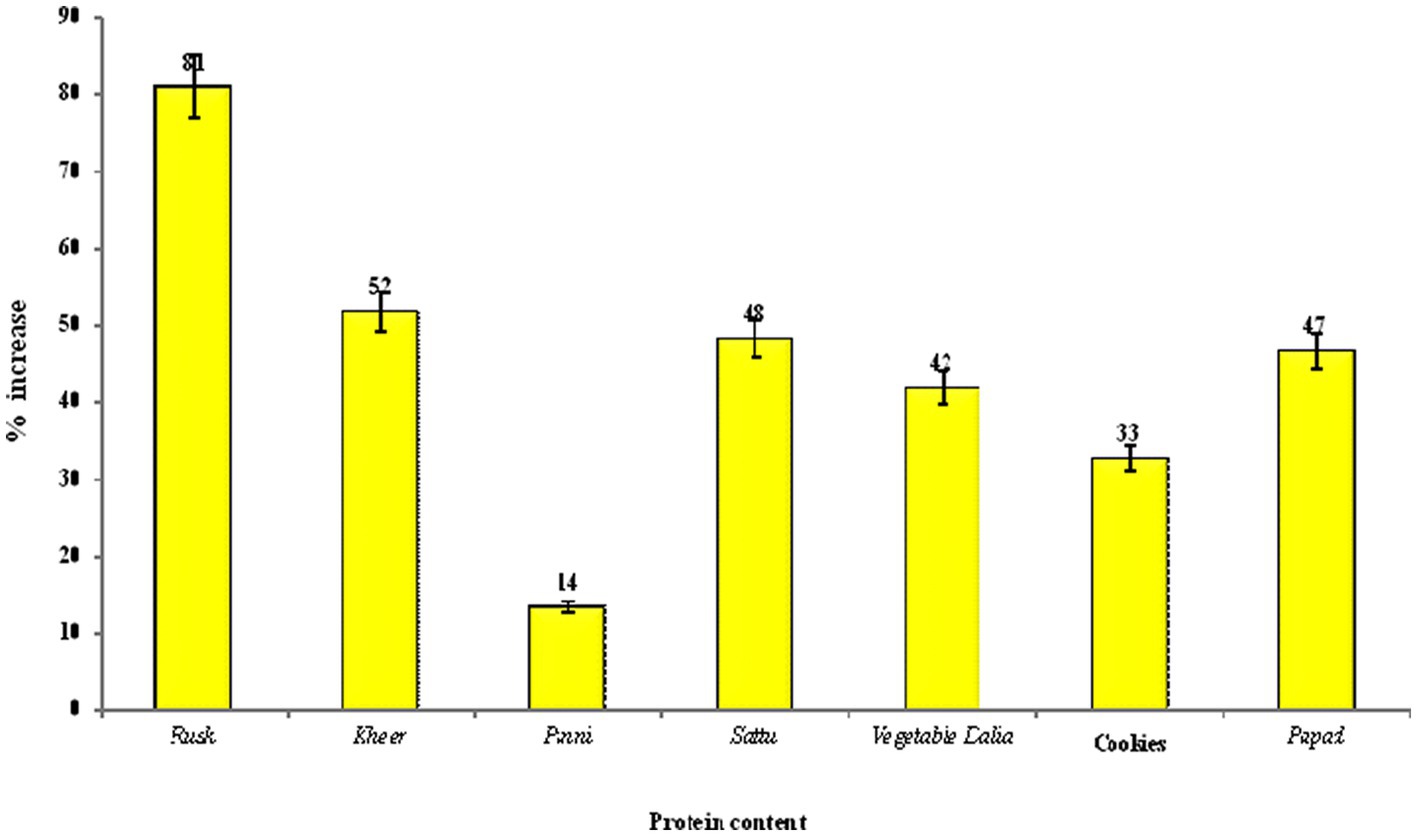
Figure 3. Percent increase in the protein content of the food products prepared from Foxtail millet with respect to control group.
The fat content of the developed products was found in the range of 3.00 ± 0.16 to 30.45 ± 0.17 g/100 g with maximum content in pinni (30.45 ± 0.17 g/100 g), while the minimum was found in sattu (3.00 ± 0.16 g/100 g). A significant difference (p ≤ 0.05) was observed in the crude fat content of the products between the control and the experimental group. The highest fiber content was found in sattu (3.86 ± 0.15 g/100 g).
All the Foxtail millet products showed a higher amount of minerals (Fe, Zn, and Ca) than their control counterparts. The iron, zinc and calcium content of the developed products ranged from 3.03 ± 0.04 to 4.21 ± 0.04, 1.37 ± 0.08 to 3.16 ± 0.07, and 53.30 ± 0.16 to 157.81 ± 0.28 mg/100 g, respectively, with the corresponding values of 0.97 ± 0.07 to 4.07 ± 0.02, 0.5 ± 0.07 to 1.89 ± 0.04 and 10.60 ± 0.18 to 110.57 ± 0.33 mg/100 g, in the traditional cereal based products. The highest iron content was found in sattu (4.21 ± 0.04 mg/100 g), whereas the highest zinc and calcium contents were observed in vegetable dalia (3.16 ± 0.07 mg/100 g) and kheer (157.81 ± 0.28 mg/100 g), respectively. On the other hand, kheer was found to have the lowest iron content (3.03 ± 0.04 mg/100 g), while cookies showed the lowest content of zinc (1.37 ± 0.08 mg/100 g) and calcium (53.30 ± 0.16 mg/100 g).
The soluble, insoluble and total dietary fiber of the developed products are presented in Table 4A. A significant (p ≤ 0.05) difference was found among the soluble, insoluble and total dietary fiber of Foxtail millet and traditional cereal-based products, with the respective values ranging from 0.41 ± 0.02 to 0.80 ± 0.02, 7.27 ± 0.16 to 12.67 ± 0.25 and 7.72 ± 0.12 to 13.47 ± 0.23 g/100 g in the Foxtail millet-based products, while the corresponding values in the control group were 0.40 ± 0.02 to 0.79 ± 0.02, 3.26 ± 0.06 to 9.62 ± 0.11 and 3.82 ± 0.06 to 10.32 ± 0.06 g/100 g, respectively. The developed products had a higher total dietary fiber content, with the highest amount of all fractions of dietary fiber found in sattu (13.47 ± 0.23 g/100 g), followed by bar (12.83 ± 0.06 g/100 g).
Rapidly digestible starch was found to be significantly (p ≤ 0.05) higher in the control group than the developed products, among which, the maximum rapidly digestible starch content was observed in papad (32.26%), while the minimum content was found in sattu (19.9%). The maximum amount of slowly digestible starch was seen in kheer (21.12%).
The resistant starch content of the developed products ranged from 13.67 ± 0.29 to 22.61 ± 0.69 g/100 g, with the corresponding values of 7.65 ± 0.29 to 16.35 ± 0.41 g/100 g found in the traditional cereal based products. The highest content of resistant starch was found in the bar (22.61 ± 0.69) g/100 g followed by vegetable dalia (17.16 ± 0.61), kheer (16.91 ± 0.34), papad (15.76 ± 0.46), cookies (15.32 ± 0.90), sattu (14.08 ± 0.34), pinni (13.67 ± 0.29), and rusk (13.97 ± 0.72) g/100 g.
The predicted glycemic index of the developed products ranged from 46.12 ± 0.12 to 57.55 ± 0.34, while the control group products had a predicted glycemic index ranging from 60.23 ± 0.30 to 72.23 ± 0.07. The lowest predicted glycemic index was found in bar (46.12 ± 0.12), followed by sattu (49.30 ± 0.19), cookies (53.05 ± 0.44), kheer (53.46 ± 0.30), papad (54.76 ± 0.14), rusk (56.27 ± 0.10), vegetable dalia (57.13 ± 0.19), and pinni (57.55 ± 0.34). The decrease in predicted glycemic index of the Foxtail millet products compared to the cereal based products is shown in Figure 4. The maximum percent decrease in GI was found in Foxtail millet pinni (18.28%), papad (16.78%), cookies (14.2%) and rusk (12.99%). Hence, the glycemic index of the products prepared from millets decreased in comparison to control group, in a range of 8–28%, proving that Foxtail millet products had a low GI in comparison to wheat and rice products (Table 4B).
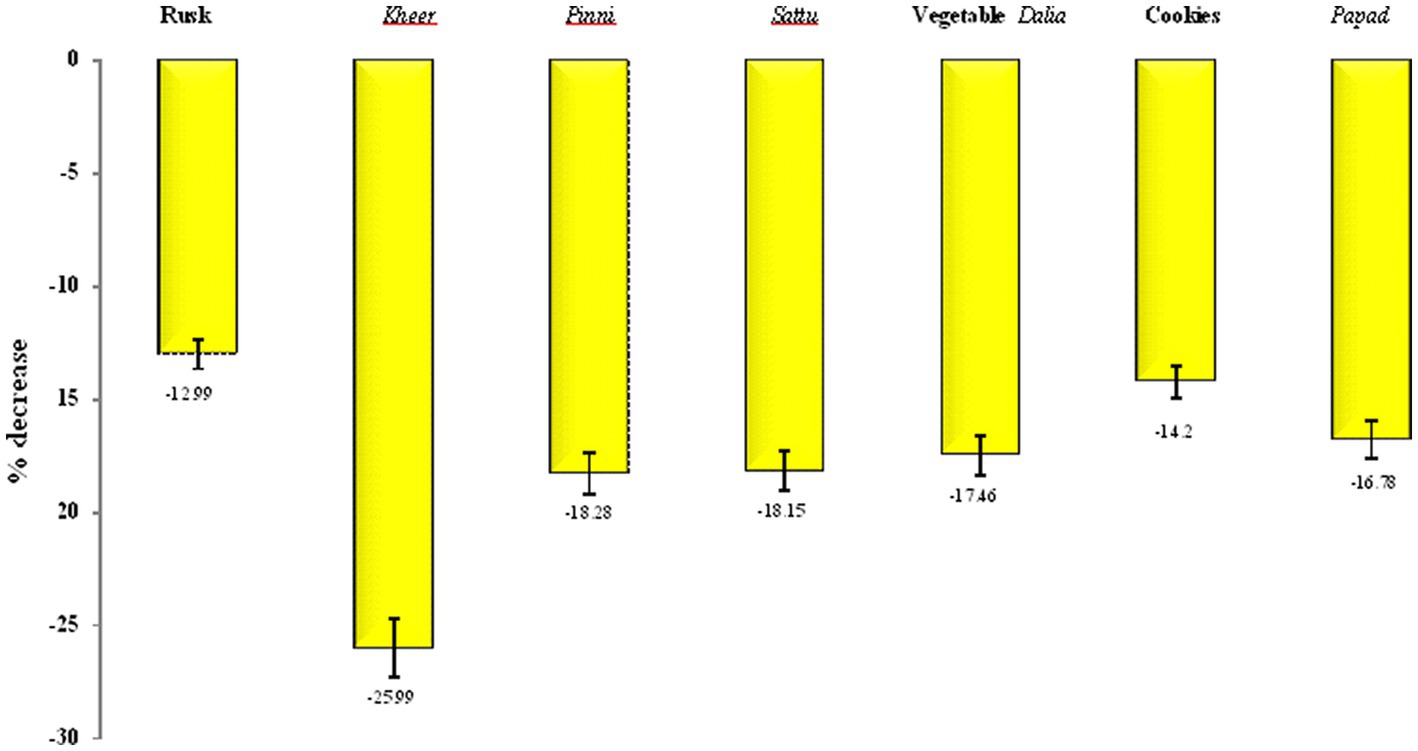
Figure 4. Percent decrease in the predicted glycemic index of the food products prepared from Foxtail millet with respect to control group.
Also, glycemic load (GL) is directly proportional to glycemic index; hence the products with low glycemic index depicted a low glycemic load, whereas the products in the control group, which had higher glycemic index were found to have a higher glycemic load. The glycemic load of the developed Foxtail millet products ranged from 4.69 ± 0.70 to 41.74 ± 0.36, with the lowest glycemic load observed in millet bar (35.15 ± 0.36), whereas the highest glycemic load was found in papad (41.74 ± 0.36). The glycemic load of kheer was low (4.69 ± 0.70), while it was found to have a glycemic index of 53.46 ± 0.30.
It was observed that at the end of 180 min of in vitro digestion, more amount of the products from the control group were digested than the millet-based products. The slowest in vitro starch digestion rate at the end of 180 min of digestion was seen in bar (51.5%). On the other hand, Foxtail millet kheer was found to have a higher rate to the tune of 87.1%, while 91.2% of the starch in rice-based kheer was found to be hydrolysed at the end of 180 min. Majority of the millet-based products were found to have a digestion rate ranging from 50 to 60%, while their control counterparts had 54.3–91.2% digestion rate at the end of 180 min (Figure 5).
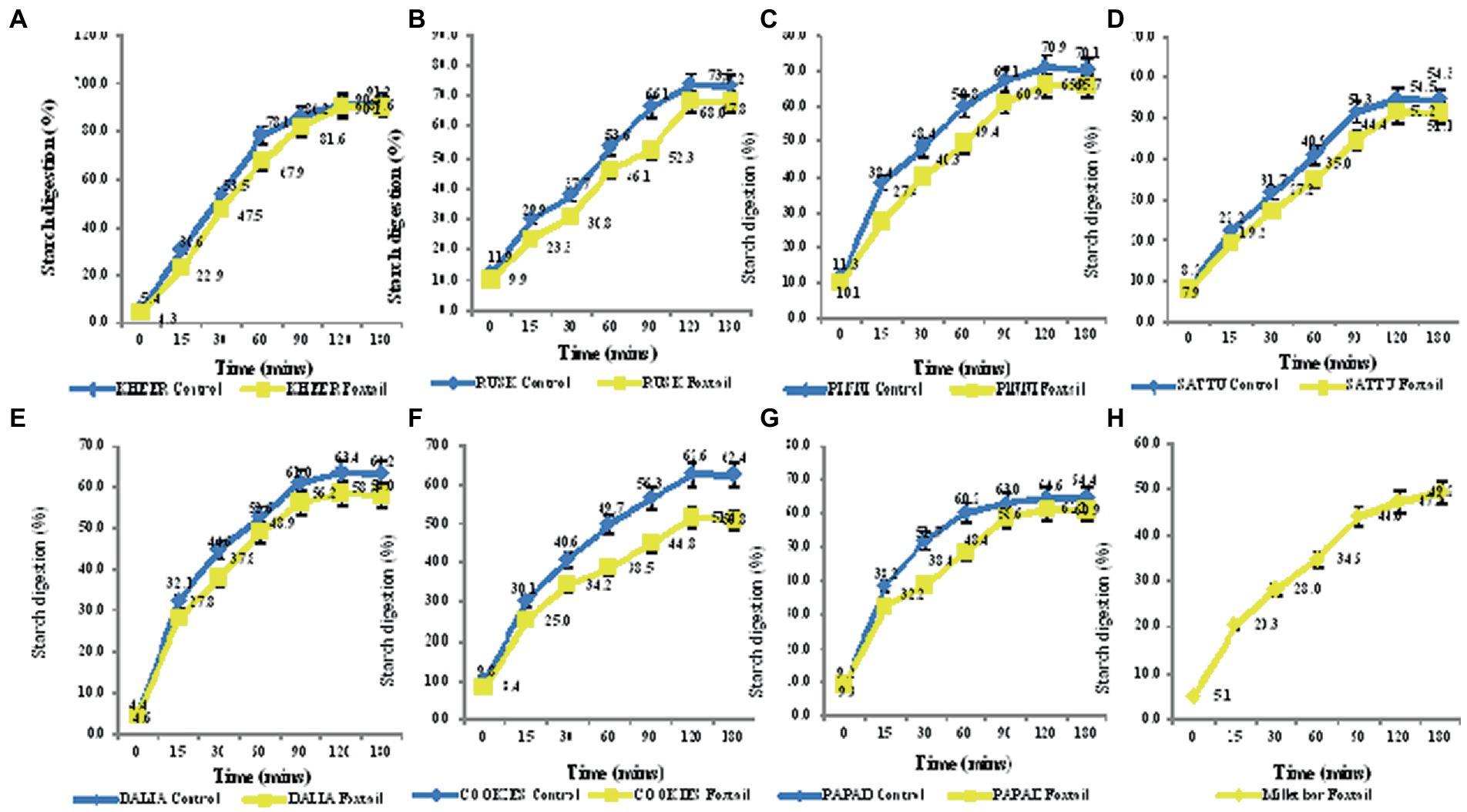
Figure 5. (A–H) In vitro starch digestion rate of value added products prepared from Foxtail millet and the control group.
5. Discussion
The present study was conducted with an objective to explore the possibility of replacement of traditional cereals, mainly wheat and rice, with millets. The millets contain low glycemic index than other cereal grains which can be due to the higher dietary fiber content and resistant starch which have the potential to slow down the absorption of glucose (35). Foxtail millet had a slower starch digestion rate than wheat, which can be due to the fact that millets have higher amount of protein than other cereals due to which there is a reduced gelatinization and enzyme permeability, resulting from the protein-starch gel’s encapsulation of starch globules. Also, a higher content of fats in millets lead to prevention of amylase entry by a lipophilic amylo-lipid inclusion complex (36). It was reported that the in vitro starch digestion rate ranged between 22.29 and 35.52% in nine varieties of Pearl millet (37). Therefore, various research studies mentioned above proved better nutritional profile of foxtail millet than wheat.
Organoleptic properties are the aspects of food, water, or other substances that a person perceives through their senses, which include taste, sight, smell, and touch. The purpose of the sensory evaluation is to describe the product. The value-added products were developed by replacing the cereal (wheat/rice) with millet using the standardized recipe. Those recipes which are already liked by the population and fit well in the Indian cuisine were selected and replaced with millets. The incorporation of millets was initiated at a level of 10% and all the recipes were found to be acceptable even at 100% replacement.
The value-added products namely rusk, kheer, pinni, sattu, vegetable dalia, papad, cookies and millet bar were developed and compared with the products prepared from traditional cereal (wheat for rusk, cookies, vegatable dalia and pinni, rice for papad and kheer and barley for sattu), which were considered as control for their organoleptic scores. The products viz., rusk, kheer, pinni, vegetable dalia, cookies and formulated from Foxtail millet in the present study obtained overall acceptability scores comparable to the control dishes. It was in line with the study, where Foxtail millet was used to make food items such as laddu, vegetable biryani, and halwa and received the highest scores for overall acceptability, color, appearance, texture, and flavor than their control counterparts (38). In another study, various combinations of Foxtail millet flour were used to make chakli mix. The chakli made entirely of Foxtail millet flour was found to have the best overall appearance, flavor, texture, and acceptability (39). Foxtail millet was used to make laddu, peanut chutney, panjeeri, kheer, cutlet, and chakli, among other things. The products were scored numerically by 38 semi-trained panelists. Laddu, kheer, and panjeeri were found to be highly acceptable, followed by peanut chutney, whereas chakli was not. Thus, Foxtail millet can be easily included in the preparation of various traditional recipes without compromising their sensory qualities (40). Many other research studies also showed higher acceptability of Foxtail millet products like cookies (41), papad (42) and millet-based drinks (43) than their traditionally prepared counterparts. The higher acceptability of millet based products can be due to the fact that during roasting and baking, browning leads to an acceptable, pleasant odor. Frying increases the palatability of the product. These cooking techniques employed might have resulted in overcoming the bitterness of the millet grains (44).
The prepared products also had a higher protein, fiber, and fat content in comparison to the control counterparts. Addition of different ingredients like milk during preparation of recipes might have increased these nutritional parameters. Literature also reports that products prepared from millets are rich sources of macronutrients (45). The difference in the fat content of the products can be due to the addition of ingredients in the recipe and the type of cooking method used. The highest fat content in pinni may be attributed to the addition of fat and flax seeds, whereas the lowest fat in sattu can be due to the roasting of grains, while preparing sattu powder. Roasting leads to denaturation of lipolytic enzymes, which may be responsible for loss of fat after processing. A reduction of 51% in the fat content was found after roasting of products (46). Laddu and halwa were developed from Foxtail and Barnyard millet and a crude fat content of 25.63 and 25.01% in laddu and 9.60 and 9.29% in halwa, respectively, were reported (38). Similarly, pearl millet papad (80% pearl millet, 20% rice flour) were prepared and a fat content of 5.55% was reported, which is in line with the present findings (47). The high fiber content in sattu can be attributed to the roasting of grains, as during roasting there is a partial degradation of cellulose and hemicellulose that decreases the insoluble dietary fiber content (48). The least fiber content observed in papad can be due to the cooking method employed. Papad was steamed prior to drying and deep- frying, which resulted in the breakdown of lignin bonds, breaking the cellulosic structure of the fiber (49).
The highest iron content in sattu can be attributed to the addition of jaggery, having a high iron content of 10–13 mg/100 g as reported by (50). The high iron content of Sattu can also be attributed to the cooking technique used, where in roasting in a regular pan led to higher iron retention as reported by (51). Similarly, the increased zinc content of vegetable dalia can be due to the fact that millet dalia was soaked prior to the cooking process and soaking of millets boosts the in vitro solubility of the zinc by 2–23% and also decreases phytic acid content (52). The maximum calcium content in kheer may be due to the higher content of calcium present in milk than the other ingredients used in various recipes. Similar results were reported by (53) in which finger millet-based sheera (prepared using Finger millet and milk) had a calcium content of 149.2 mg/100 g.
The total starch content of the products prepared from traditional cereals was significantly (p ≤ 0.05) higher than the Foxtail millet products, which ranged from 50.50 ± 1.09 to 62.92 ± 1.18 g/100 g, with the highest content found in the Foxtail millet kheer. The highest total starch content in kheer was due to the addition of sugar, which increased the total carbohydrate content and hence, the total starch content. The more rapidly digestible starch in papad can be due to frying of papad. Frying affects starch digestibility in terms of structural damage which leads to an increase in rapidly digestible starch (54). Slowly digestible starch content was observed in vegetable dalia (5.06%) which can be due to pressure cooking that results in maximum gelatinization, that increases the content of rapidly digestible starch and reducing slowly digestible starch (55). The maximum amount of slowly digestible starch in Kheer may be because of its refrigeration prior to serving, which led to a new structure formation converting the RDS to SDS, hence, increasing the slowly digestible starch and reducing the rapidly digestible starch (56).
A significant difference (p ≤ 0.05) was seen in the resistant starch content of the products prepared from Foxtail millet and the traditional cereal except in the case of kheer. The temperature at which food is kept after cooking affects its resistant starch content (57). The refrigeration results in increased resistant starch content, and, therefore, it should be consumed after sufficient refrigeration so as to gain maximum health benefits.
Resistant starch content of the products is greatly affected by the cooking technique. The cooking methods like pressure cooking, boiling, microwave cooking and baking lead to a decrease in its concentration, while roasting can potentially retain the resistant starch content (58), which is in line with the findings of the present study. Moreover, the cooking process can affect the starch digestion rate. The structure of starch in foods changes at higher temperatures (52). Roasting is a relatively dry thermal process that hinders gelatinization of starch during processing and may result in decreasing starch digestion rate (58). The highest resistant starch in bar can be attributed to the fact that Millet bar was prepared with roasting, which is one of the efficient ways to retain it in millets (58). Foods high in resistant starch are favorable for the people suffering from diabetes and cardiovascular diseases (57), as this starch is not rapidly digested in the body and is fermented in the colon by microorganisms (59). The millet grain is superior to other cereals in terms of both the quality and amount of dietary fiber and resistant starch. These ingredients help to prolong the sense of fullness and avoid constipation. Furthermore, by binding to toxins in the stomach, they protect the colon mucosa from cancer (57).
The glycemic index of the product depends upon its total available carbohydrate content and the type of starch present in it. Also, the high concentration of polyphenols and other bioactive components lead to reduction in the rate of fat absorption and sugar release resulting in lesser glycemic index (13). Moreover, higher amount of resistant starch, protein and dietary fiber lowers the predicted glycemic index of the food product. The millet bar and sattu had the lowest glycemic index, which can be due to their higher resistant starch and higher dietary fiber content. In the current investigation, millet-based products showed a lower GI than the wheat/rice-based products. The lower glycemic load of kheer can be due to its high moisture content as high moisture content of the food results in a lower available carbohydrate content of the food product, resulting in a lower glycemic load. It has been reported that watermelon and high-fat ice cream have glycemic index of 72 and 37, respectively, whereas both were found to have same glycemic load of 4, which was attributed to high moisture content of watermelon that led to lesser available carbohydrate leading to a lower glycemic load (60).
Similar to the findings of the present study, biscuits were prepared from barnyard millet and refined wheat flour in the combination of 45:55 ratio and their glycemic index was reported as 68 (41), whereas barnyard millet burfi prepared by adding 43% millet had a glycemic index of 45 (61). The GI of food products made from 100% proso millet was 50–65, compared to 70–80 for refined corn and wheat-based products. Millets have a lower glycemic index (GI) than wheat, rice, and barley, making them an ideal food for people with type 2 diabetes and cardiovascular disease (CVD) (62). The protective role of millets against hyperglycemia by replacing rice-based dosa with Foxtail millet dosa for people with type 2 diabetes was demonstrated by switching from a meal made of rice to one made of millet, which decreased postprandial blood glucose levels in T2DM patients (63).
The slow digestion rate of Foxtail millet-based products can be due to the presence of higher amounts of protein and fat than wheat-rice products. It was reported that during processing, starch can interact with proteins, which is thought to affect starch digestibility (64). Denatured protein may stick to starch granules, preventing enzyme absorption. Also the gel that results from the hydrophilic interaction of protein and starch can enclose globules and even influence the gelatinization process. The impact of protein on in vitro starch digestion rate and the in vitro glycemic response was studied and an increase in both due to absence of protein starch complex was reported (65). Similarly, the presence of high lipid content reduces the in vitro starch digestion rate by forming a lipophilic amylo-lipid inclusion complex, which refrains the entry of amylase (66). The higher amount of dietary fiber in millets also reduces the in vitro starch digestion rate, by binding the water and reducing gelatinization (67).
6. Conclusion
Foxtail millet-based food products were developed by 100% replacement of wheat/rice/barley. The developed food products obtained acceptable sensory scores and were found to be at par against the traditional products. The foxtail millet-based products contained higher levels of protein, dietary fiber, resistant starch, and had lower glycemic index and starch digestion rate than wheat/ rice/ barley-based products. The developed Foxtail millet products can be categorized as foods with a medium glycemic index and can be used as therapeutic foods for diabetics. Kheer prepared from Foxtail millet also had high fiber and calcium contents, which can be useful for osteoporosis and can be consumed as a healthy snack. The formulated Foxtail millet products can be helpful in the prevention of non- communicable diseases like diabetes and obesity, owing to its high fiber, resistant starch and lower glycemic index.
Data availability statement
The raw data supporting the conclusions of this article will be made available by the authors, without undue reservation.
Author contributions
LA: investigation, methodology, and writing—original draft. RA: supervision and project administration. RA and ID: conceptualization, resources, and final draft. OG and PK: formal analysis and final draft. All authors contributed to the article and approved the submitted version.
Conflict of interest
The authors declare that the research was conducted in the absence of any commercial or financial relationships that could be construed as a potential conflict of interest.
Publisher’s note
All claims expressed in this article are solely those of the authors and do not necessarily represent those of their affiliated organizations, or those of the publisher, the editors and the reviewers. Any product that may be evaluated in this article, or claim that may be made by its manufacturer, is not guaranteed or endorsed by the publisher.
References
1. FAO. GIEWS – Global Information and Early Warning System. (2020). Available at: http://www.fao.org/giews/countrybrief/country.jsp?code=IND&lang=en
2. Ramadas, S, Kumar, TM, and Singh, GP. Wheat production in India: Trends and prospects In: F Shah, Z Khan, A Iqbal, M Turan, and M Olgun, editors. Recent advances in grain crops research. Rijeka: IntechOpen (2019). 1–16.
3. Abrol, IP. Sustaining rice–wheat system productivity in the indo-Gangetic plains: Water management-related issues. Agric Water Manag. (1999) 40:31–5. doi: 10.1016/S0378-3774(98)00100-0
4. Tokunaga, M, Takahashi, TB, Singh, R, Rupini, D, Toda, E, Nakamura, T, et al. Diet, nutrients and noncommunicable diseases. Tonutraj. (2012) 5:146–59. doi: 10.2174/1876396001205010146
5. Anand, T, Kishore, J, Isaakidis, P, Gupte, HA, Kaur, G, Kumari, S, et al. Integrating screening for non-communicable diseases and their risk factors in routine tuberculosis care in Delhi, India: A mixed-methods study. PLoS One. (2018) 13:e0202256. doi: 10.1371/journal.pone.0202256
6. Girish, C, Meena, RK, Mahima, D, and Mamta, K. Nutritional properties of minor millets: Neglected cereals with potentials to combat malnutrition. Curr Sci. (2014) 107:1109–11.
7. Ritchie, H, Reay, DS, and Higgins, P. Quantifying, projecting, and addressing India's hidden hunger. Front Sustain Food Syst. (2018) 2:11. doi: 10.3389/fsufs.2018.00011
8. Kumar, N, and Kumar, A. Biofortification: A plausible antidote to India’s hidden hunger problem. Int Food Policy Res Inst. (2020).
9. Saleh, AS, Zhang, Q, Chen, J, and Shen, Q. Millet grains: Nutritional quality, processing, and potential health benefits. Compr Rev Food Sci Food Saf. (2013) 12:281–95. doi: 10.1111/1541-4337.12012
10. Parameswaran, KP, and Sadasivam, S. Changes in the carbohydrates and nitrogenous components during germination of proso millet, Panicum miliaceum. Plant Food Hum Nutr. (1994) 45:97–102. doi: 10.1007/BF01088466
11. Sarita, ES, and Singh, E. Potential of millets: Nutrients composition and health benefits. J Sci Innov Res. (2016) 5:46–50. doi: 10.31254/jsir.2016.5204
12. Kumar, A, Tomer, V, Kaur, A, Kumar, V, and Gupta, K. Millets: A solution to agrarian and nutritional challenges. Agric Food Sec. (2018) 7:1–5. doi: 10.1186/s40066-018-0183-3
13. Tripathi, MK, Mohapatra, D, Jadam, RS, Pandey, S, Singh, V, Kumar, V, et al. Nutritional composition of millets In: Millets and millet technology. eds. A. Kumar, M. K. Tripathi, D. Joshi, and V. Kumar. Singapore: Springer (2021). 101–19.
14. Rawat, L, Karnatak, AK, Nautiyal, BP, Bisht, TS, and Nautiyal, A. Management of shoot fly damage in barnyard millet by seed treatment for higher monetary return in hills of Uttarakhand. J Entomol Zool Stud. (2020) 8:1762–7.
15. Shan, S, Li, Z, Newton, IP, Zhao, C, Li, Z, and Guo, M. A novel protein extracted from foxtail millet bran displays anti-carcinogenic effects in human colon cancer cells. Toxicol Lett. (2014) 227:129–38. doi: 10.1016/j.toxlet.2014.03.008
16. Singh, RB, Fedacko, J, Mojto, V, Isaza, A, Dewi, M, Watanabe, S, et al. Effects of millet based functional foods rich diet on coronary risk factors among subjects with diabetes mellitus: A single arm real world observation from hospital registry. MOJ Public Health. (2020) 9:18–25. doi: 10.15406/mojph.2020.09.00318
17. Lee, SH, Chung, IM, Cha, YS, and Park, Y. Millet consumption decreased serum concentration of triglyceride and C-reactive protein but not oxidative status in hyperlipidemic rats. Nutr Res. (2010) 30:290–6. doi: 10.1016/j.nutres.2010.04.007
18. Taylor, JR, Schober, TJ, and Bean, SR. Novel food and non-food uses for sorghum and millets. J Cereal Sci. (2006) 44:252–71. doi: 10.1016/j.jcs.2006.06.009
19. Thathola, A, and Srivastava, S. Physicochemical properties and nutritional traits of millet- based weaning food suitable for infants of the Kumaon hills, northern India. Asia Pac J Clin Nutr. (2002) 11:28–32. doi: 10.1046/j.1440-6047.2002.00251.x
20. Chhavi, A, and Sarita, S. Evaluation of composite millet breads for sensory and nutritional qualities and glycemic response. Malaysian J Nutr. (2012) 18:89–101.
21. Deshpande, HW, and Poshadri, A. Physical and sensory characteristics of extruded snacks prepared from foxtail millet based composite flours. Int Food Res J. (2011) 18:751–6.
22. Thathola, A, Srivastava, S, and Singh, G. Effect of foxtail millet (Setaria italica) supplementation on serum glucose, serum lipids and glycosylated hemoglobin in type 2 diabetics. Diabetol. Croat. (2011) 40:23–9.
23. Jeong, MS, Ko, JY, Song, SB, Lee, JS, Jung, TW, Yoon, YH, et al. Physicochemical characteristics of Sikhye (Korean traditional rice beverage) using foxtail millet, proso millet, and sorghum. J Korean Soc Food Sci Nutr. (2014) 43:1785–90. doi: 10.3746/jkfn.2014.43.11.1785
24. Das, S, Khound, R, Santra, M, and Santra, DK. Beyond bird feed: Proso millet for human health and environment. Agriculture. (2019) 9:64. doi: 10.3390/agriculture9030064
25. AOAC. Official Methods of Analysis. 16th ed. Washington, DC: Association of Official Analytical Chemists (2000).
26. AOAC. Official Methods of Analysis. 16th ed. Washington, DC: Association of Official Analytical Chemists (2002).
27. Goñi, I, Garcia-Alonso, A, and Saura-Calixto, F. A starch hydrolysis procedure to estimate glycemic index. Nutr Res. (1997) 17:427–37. doi: 10.1016/S0271-5317(97)00010-9
28. Haque, EU, Afzaal, S, Hayat, A, Murtaza, MA, Din, A, Ali, SW, et al. Rice-based products. In Modern techniques of Rice crop production. Sarwar, N., Atique-ur-Rehman,, Ahmad, S., and Hasanuzzaman, M. (Eds), 10 (pp. 781–807). Singapore: Springer Singapore. (2022)
29. Talwar, G, and Brar, SK. Study of physiochemical, sensory and color properties of pinni variants. Indian J Sci Technol. (2015) 8:629. doi: 10.17485/ijst/2015/v8i7/63132
30. Singh, P, Vyas, H, Vasava, A, Vasani, D, and Patil, S. Standardization and sensory evaluation of Sattu-Mantha: A traditional energy drink. Int J Ayurvedic Med. (2021) 12:583–7. doi: 10.47552/ijam.v12i3.2074
31. Goel, S, Kochar, GK, and Kaur, T. Development and organoleptic evaluation of food preparations incorporated with selected antidiabetic medicinal plants. Stud Ethno Med. (2011) 5:101–6. doi: 10.1080/09735070.2011.11886396
32. Manley, D. Manley’s technology of biscuits, crackers and cookies, vol. 28. Cambridge, UK: Elsevier, Woodhead Publishing Limited. (2011).
33. Patel, PM, Siripurapu, SC, and Shah, BP. Drying, packaging and storage of papads-a review. Agric Eng Today. (2000) 24:22–31.
34. Nicolas, L, Marquilly, C, and O’Mahony, M. The 9-point hedonic scale: Are words and numbers compatible? Food Qual Prefer. (2010) 21:1008–15. doi: 10.1016/j.foodqual.2010.05.017
35. Jenkins, DJ, and Jenkins, AL. Dietary fiber and the glycemic response. Exp Biol Med. (1985) 180:422–31. doi: 10.3181/00379727-180-42199
36. Annor, GA, Tyl, C, Marcone, M, Ragaee, S, and Marti, A. Why do millets have slower starch and protein digestibility than other cereals? Trends Food Sci Technol. (2017) 66:73–83. doi: 10.1016/j.tifs.2017.05.012
37. Lemgharbi, M, Souilah, R, Belhadi, B, Terbag, L, Djabali, D, and Nadjemi, B. Starch digestion in pearl millet (Pennisetum glaucum (L.) R. Br.) flour from arid area of Algeria. J Applied Bot Food Qual. (2017) 90:126–31.
38. Verma, S, Srivastava, S, and Tiwari, N. Comparative study on nutritional and sensory quality of barnyard and foxtail millet food products with traditional rice products. J Food Sci Technol. (2015) 52:5147–55. doi: 10.1007/s13197-014-1617-y
39. Namitha, MY, Chavan, UD, Kotecha, PM, and Lande, SB. Studies on nutritional and sensory qualities of foxtail millet chakli. Int J Food Sci Nutr. (2019) 4:68–73.
40. Fatima, Z, and Rao, A. Development, organoleptic evaluation and acceptability of products developed by incorporating foxtail millet. J Food Sci Nutr Res. (2019) 2:128–35. doi: 10.26502/jfsnr.2642-11000014
41. Anju, T, and Sarita, S. Suitability of foxtail millet (Setaria italica) and barnyard millet (Echinochloa frumentacea) for development of low glycemic index biscuits. Malays J Nutr. (2010) 16:361–8.
42. Chavan, UD, Pansare, SS, Patil, JV, and Shinde, MS. Preparation and nutritional quality of sorghum papads. Int J Curr Microbiol App Sci. (2015) 4:806–23.
43. Bembem, K, and Agrahar-Murugkar, D. Development of millet based ready-to-drink beverage for geriatric population. J Food Sci Technol. (2020) 57:3278–83. doi: 10.1007/s13197-020-04359-9
44. Mosayebi, M, Kashaninejad, M, and Najafian, L. Optimizing physiochemical and sensory properties of infrared-hot air roasted sunflower kernels using response surface methodology. J Food Qual. (2018) 2018:1–14. doi: 10.1155/2018/4186050
45. Bojarczuk, A, Skąpska, S, Mousavi Khaneghah, A, and Marszałek, K. Health benefits of resistant starch: A review of the literature. J Funct Foods. (2022) 93:105094. doi: 10.1016/j.jff.2022.105094
46. Yousaf, L, Hou, D, Liaqat, H, and Shen, Q. Millet: A review of its nutritional and functional changes during processing. Food Res Int. (2021) 142:110197. doi: 10.1016/j.foodres.2021.110197
47. Kalange, ND, Chavan, UD, Kotecha, PM, and Pawase, PA. Studies on physico-chemical properties of papad prepared from different cultivar of pearl millet. Int J Food Sci Nutr. (2021) 5:99–103.
48. Benítez, V, Mollá, E, Martín-Cabrejas, MA, Aguilera, Y, López-Andréu, FJ, Cools, K, et al. Characterization of industrial onion wastes (Allium cepa L.): Dietary fibre and bioactive compounds. Plant Foods Hum Nutr. (2011) 66:48–57. doi: 10.1007/s11130-011-0212-x
49. Darmanto, S, Rochardjo, HS, and Jamasri, WR. Effects of alkali and steaming on mechanical properties of snake fruit (Salacca) fiber. AIP Conf Proc. (2017) 1788:030060.
50. Hirpara, P, Thakare, N, Kele, VD, and Patel, D. Jaggery: A natural sweetener. J Pharma Phytochem. (2020) 9:3145–8.
51. Pereira, EJ, Carvalho, LM, Dellamora-Ortiz, GM, Cardoso, FS, Carvalho, JL, Viana, DS, et al. Effects of cooking methods on the iron and zinc contents in cowpea (Vigna unguiculata) to combat nutritional deficiencies in Brazil. Food Nutr Res. (2014) 58:20694. doi: 10.3402/fnr.v58.20694
52. Hendek Ertop, M, and Bektaş, M. Enhancement of bioavailable micronutrients and reduction of antinutrients in foods with some processes. Food Health. (2018) 4:159–65. doi: 10.3153/FH18016
53. Kazi, T, and Auti, SG. Calcium and iron rich recipes of finger millet. IOSR J Biotechnol Biochem. (2017) 3:64–8. doi: 10.9790/264X-03036468
54. Ding, Y, Yang, L, Xia, Y, Wu, Y, Zhou, Y, and Wang, H. Effects of frying on starch structure and digestibility of glutinous rice cakes. J Cereal Sci. (2018) 83:196–203. doi: 10.1016/j.jcs.2018.08.014
55. Rashmi, S, and Urooj, A. Effect of processing on nutritionally important starch fractions in rice varieties. Int J Food Sci Nutr. (2003) 54:27–36. doi: 10.1080/096374803161976
56. Mishra, S, Monro, J, and Hedderley, D. Effect of processing on slowly digestible starch and resistant starch in potato. Starch-Stärke. (2008) 60:500–7. doi: 10.1002/star.200800209
57. Strozyk, S, Rogowicz-Frontczak, A, Pilacinski, S, LeThanh-Blicharz, J, Koperska, A, and Zozulinska-Ziolkiewicz, D. Influence of resistant starch resulting from the cooling of rice on postprandial glycemia in type 1 diabetes. Nutr Diabetes. (2022) 12:1–6. doi: 10.1038/s41387-022-00196-1
58. Kaimal, AM, Mujumdar, AS, and Thorat, BN. Resistant starch from millets: Recent developments and applications in food industries. Trends Food Sci Technol. (2021) 111:563–80. doi: 10.1016/j.tifs.2021.02.074
59. Rashed, AA, Saparuddin, F, Rathi, DN, Nasir, NN, and Lokman, EF. Effects of resistant starch interventions on metabolic biomarkers in pre-diabetes and diabetes adults. Front Nutr. (2022) 8:1253. doi: 10.3389/fnut.2021.793414
60. Venn, BJ, and Green, TJ. Glycemic index and glycemic load: Measurement issues and their effect on diet–disease relationships. Eur J Clin Nutr. (2007) 61:S122–31. doi: 10.1038/sj.ejcn.1602942
61. Bisht, AT, and Srivastava, S. Efficacy of millets in the development of low glycemic index sweets for diabetics. Malays J Nutr. (2013) 19:215–2.
62. McSweeney, MB, Seetharaman, K, Ramdath, DD, and Duizer, LM. Chemical and physical characteristics of proso millet (Panicum miliaceum)-based products. Cereal Chem. (2017) 94:357–62. doi: 10.1094/CCHEM-07-16-0185-R
63. Narayanan, J, Sanjeevi, V, Rohini, U, Trueman, P, and Viswanathan, V. Postprandial glycaemic response of foxtail millet dosa in comparison to a rice dosa in patients with type 2 diabetes. Indian J Med Res. (2016) 144:712. doi: 10.4103/ijmr.IJMR_551_15
64. Guerrieri, N, Eynard, L, Lavelli, V, and Cerletti, P. Interactions of protein and starch studied through amyloglucosidase action. Cereal Chem. (1997) 74:846–50. doi: 10.1094/CCHEM.1997.74.6.846
65. Ren, X, Chen, J, Molla, MM, Wang, C, Diao, X, and Shen, Q. In vitro starch digestibility and in vivo glycemic response of foxtail millet and its products. Food Funct. (2016) 7:372–9. doi: 10.1039/C5FO01074H
66. Sajilata, MG, Singhal, RS, and Kulkarni, PR. Resistant starch–a review. Comp Rev Food Sci Food Safety. (2006) 5:1–7. doi: 10.1111/j.1541-4337.2006.tb00076.x
Keywords: foxtail millet, value-added products, protein, resistant starch, predicted glycemic index
Citation: Arora L, Aggarwal R, Dhaliwal I, Gupta OP and Kaushik P (2023) Assessment of sensory and nutritional attributes of foxtail millet-based food products. Front. Nutr. 10:1146545. doi: 10.3389/fnut.2023.1146545
Edited by:
Satyanarayan R. S. Dev, Florida Agricultural and Mechanical University, United StatesReviewed by:
Aurea K. Ramírez-Jiménez, Monterrey Institute of Technology and Higher Education (ITESM), MexicoEmmanuel Anyachukwu Irondi, Kwara State University, Nigeria
Copyright © 2023 Arora, Aggarwal, Dhaliwal, Gupta and Kaushik. This is an open-access article distributed under the terms of the Creative Commons Attribution License (CC BY). The use, distribution or reproduction in other forums is permitted, provided the original author(s) and the copyright owner(s) are credited and that the original publication in this journal is cited, in accordance with accepted academic practice. No use, distribution or reproduction is permitted which does not comply with these terms.
*Correspondence: Renuka Aggarwal, cmVudWthYWdnYXJ3YWxAcGF1LmVkdQ==; Prashant Kaushik, cHJha2F1QGRvY3Rvci51cHYuZXM=
 Laghima Arora
Laghima Arora Renuka Aggarwal
Renuka Aggarwal Inderpreet Dhaliwal
Inderpreet Dhaliwal Om Prakash Gupta
Om Prakash Gupta Prashant Kaushik
Prashant Kaushik